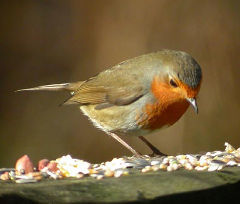Overview
 Order: Passeriformes
Order: Passeriformes
Family: Muscicapidae
Species: Erithacus rubecula (European Robin)
IUCN Status: Least Concern
Population Trend: increasing
Distribution: all over Europe, except for parts of the Mediterranean coast and northern Scandinavia. Also found in the Azores, Canary Islands and parts of North Africa; eastwards into central Russia, Turkey and Iran.
Habitat: natural woodland, hedgerows, parks and gardens.
Description: orange-red face and breast with pale grey border. Upper parts and tail brown; white underparts.
Size: Length:- 14cm. Wingspan:- 26cm. Weight:- 19.5g
Life-span: oldest known bird 13 years. Usually live for a few years only.
Food: insects, worms, seeds and berries.
The robin is a popular visitor to gardens and is well-known for its tameness - with patience it can even be encouraged to eat from the hand. Robins living elsewhere in Europe are much more wary of humans because there they are shot in their thousands for food or sport.
Read More: Territory